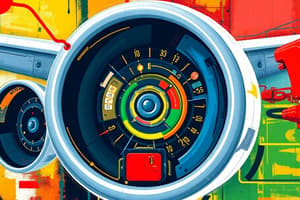Podcast
Questions and Answers
In a commercial aircraft fuel system, what is the primary purpose of the surge tank in the wing?
In a commercial aircraft fuel system, what is the primary purpose of the surge tank in the wing?
- To provide a reserve of fuel in case of main tank failure.
- To store extra fuel for extended range.
- To house the fuel pumps and control valves.
- To accommodate fuel expansion and prevent spillage. (correct)
Why are flexible fuel tanks advantageous in aircraft design?
Why are flexible fuel tanks advantageous in aircraft design?
- They can be easily shaped and fitted into irregular spaces within the aircraft structure. (correct)
- They are more resistant to impact damage than rigid tanks.
- They offer better thermal insulation for the fuel compared to integral tanks.
- Their rigid structure provides enhanced structural support to the aircraft.
What is the significance of ensuring that the compartment for a flexible fuel tank is as smooth as possible?
What is the significance of ensuring that the compartment for a flexible fuel tank is as smooth as possible?
- To maximize the fuel capacity of the tank.
- To prevent chafing and wear on the flexible tank material. (correct)
- To facilitate easier installation and removal of the tank.
- To improve the thermal insulation of the tank.
Which of the following best describes the construction of rigid fuel tanks used in aircraft?
Which of the following best describes the construction of rigid fuel tanks used in aircraft?
What is the primary purpose of a sequence valve in an aircraft fuel system?
What is the primary purpose of a sequence valve in an aircraft fuel system?
What is the approximate output flow rate of a typical fuel pump (booster pump) installed in an aircraft fuel tank?
What is the approximate output flow rate of a typical fuel pump (booster pump) installed in an aircraft fuel tank?
Why is it important to have water draining valves at the lowest points of each fuel tank?
Why is it important to have water draining valves at the lowest points of each fuel tank?
What is a key characteristic of integral fuel tanks?
What is a key characteristic of integral fuel tanks?
In the event of a fire, which component is activated to isolate the fuel system?
In the event of a fire, which component is activated to isolate the fuel system?
Which of these components allows an aircraft to rapidly decrease its weight in emergency situations?
Which of these components allows an aircraft to rapidly decrease its weight in emergency situations?
What design consideration allows for fuel expansion without spillage in commercial aircraft fuel tanks?
What design consideration allows for fuel expansion without spillage in commercial aircraft fuel tanks?
What is the function of the air vent fitted to the top of each fuel tank?
What is the function of the air vent fitted to the top of each fuel tank?
What is the main difference between a gravity feed fuel system and a pump feed fuel system?
What is the main difference between a gravity feed fuel system and a pump feed fuel system?
What is the maximum fuel pressure at zero flow for a typical fuel pump?
What is the maximum fuel pressure at zero flow for a typical fuel pump?
Where is the Low Pressure (LP) shutoff valve typically located?
Where is the Low Pressure (LP) shutoff valve typically located?
What is the main purpose of a fuel cross-feed system in an aircraft?
What is the main purpose of a fuel cross-feed system in an aircraft?
What is the primary purpose of 'inwards and outwards venting' in aircraft fuel tanks?
What is the primary purpose of 'inwards and outwards venting' in aircraft fuel tanks?
Why are open-vented fuel systems less common in modern high-altitude aircraft?
Why are open-vented fuel systems less common in modern high-altitude aircraft?
What is the function of a vent float valve in an aircraft fuel tank?
What is the function of a vent float valve in an aircraft fuel tank?
In a modern aircraft, what type of sensor is typically used for fuel level sensing?
In a modern aircraft, what type of sensor is typically used for fuel level sensing?
What is the purpose of high-level sensing in an aircraft fuel tank?
What is the purpose of high-level sensing in an aircraft fuel tank?
What happens when the high-level shut-off system fails during refueling, and fuel enters the vent tank?
What happens when the high-level shut-off system fails during refueling, and fuel enters the vent tank?
What is the significance of having separate low-level sensing for outer and inner/center fuel tanks?
What is the significance of having separate low-level sensing for outer and inner/center fuel tanks?
If the outer tank low-level sensor is exposed to air, what indication will the flight crew typically receive?
If the outer tank low-level sensor is exposed to air, what indication will the flight crew typically receive?
In what operational mode are the inner/centre tank low-level sensing systems active?
In what operational mode are the inner/centre tank low-level sensing systems active?
What is the primary purpose of the calibration sensors installed in the fuel trim tank?
What is the primary purpose of the calibration sensors installed in the fuel trim tank?
What action is triggered when the fuel level in either outer tank drops below a certain threshold?
What action is triggered when the fuel level in either outer tank drops below a certain threshold?
Which component is NOT part of the fuel quantity measurement and indication system?
Which component is NOT part of the fuel quantity measurement and indication system?
In the context of capacitance gauging, what is the variable factor that affects the amount of charge held in a fuel tank capacitor stack?
In the context of capacitance gauging, what is the variable factor that affects the amount of charge held in a fuel tank capacitor stack?
What happens to the dielectric as the fuel level in a tank decreases?
What happens to the dielectric as the fuel level in a tank decreases?
How many probes are installed in each centre tank of a wide-bodied twin aircraft fitted with a fuel trim system, according to examples given?
How many probes are installed in each centre tank of a wide-bodied twin aircraft fitted with a fuel trim system, according to examples given?
Which of the following is a crucial safety precaution to observe during aircraft refuelling operations?
Which of the following is a crucial safety precaution to observe during aircraft refuelling operations?
During aircraft defueling with a pressure-type system, what combination of equipment is used to transfer fuel from the aircraft to the bowser?
During aircraft defueling with a pressure-type system, what combination of equipment is used to transfer fuel from the aircraft to the bowser?
What is a crucial safety precaution to observe during aircraft refueling operations with a fuel bowser?
What is a crucial safety precaution to observe during aircraft refueling operations with a fuel bowser?
In large aircraft, how is longitudinal balance during flight primarily maintained as fuel is consumed?
In large aircraft, how is longitudinal balance during flight primarily maintained as fuel is consumed?
Why is the position of fuel tanks more critical in small aircraft compared to large aircraft?
Why is the position of fuel tanks more critical in small aircraft compared to large aircraft?
What is the primary purpose of a fully automatic fuel scheduling system in modern high-performance aircraft?
What is the primary purpose of a fully automatic fuel scheduling system in modern high-performance aircraft?
Flashcards
Fuel Systems
Fuel Systems
Systems designed to store and deliver fuel to engines and APU in aircraft.
Types of Fuel Systems
Types of Fuel Systems
Includes Gravity Feed and Pump Feed systems for fuel delivery.
Gravity Feed Fuel System
Gravity Feed Fuel System
A system where fuel flows to engines due to gravity without a pump.
Pump Feed Fuel System
Pump Feed Fuel System
Signup and view all the flashcards
Rigid Fuel Tank
Rigid Fuel Tank
Signup and view all the flashcards
Flexible Fuel Tank
Flexible Fuel Tank
Signup and view all the flashcards
Integral Fuel Tank
Integral Fuel Tank
Signup and view all the flashcards
Water Draining Valves
Water Draining Valves
Signup and view all the flashcards
Fuel Pumps (Booster Pumps)
Fuel Pumps (Booster Pumps)
Signup and view all the flashcards
Sequence Valves
Sequence Valves
Signup and view all the flashcards
Transfer Valves
Transfer Valves
Signup and view all the flashcards
Low Pressure Shutoff Valve
Low Pressure Shutoff Valve
Signup and view all the flashcards
Fuel Jettison
Fuel Jettison
Signup and view all the flashcards
Fuel Collector Tanks
Fuel Collector Tanks
Signup and view all the flashcards
Fuel Strainers
Fuel Strainers
Signup and view all the flashcards
Vent System
Vent System
Signup and view all the flashcards
Bowser Positioning
Bowser Positioning
Signup and view all the flashcards
Defueling Procedure
Defueling Procedure
Signup and view all the flashcards
Longitudinal Balance
Longitudinal Balance
Signup and view all the flashcards
Automatic Fuel Scheduling
Automatic Fuel Scheduling
Signup and view all the flashcards
Inner/Centre Tank Low Level Sensing
Inner/Centre Tank Low Level Sensing
Signup and view all the flashcards
Calibration Sensing
Calibration Sensing
Signup and view all the flashcards
Full Level Sensing
Full Level Sensing
Signup and view all the flashcards
Fuel Quantity Measurement Tasks
Fuel Quantity Measurement Tasks
Signup and view all the flashcards
Capacitance Gauging Principles
Capacitance Gauging Principles
Signup and view all the flashcards
Fuel Quantity Indicating System
Fuel Quantity Indicating System
Signup and view all the flashcards
Safety Precautions for Refueling
Safety Precautions for Refueling
Signup and view all the flashcards
Fuel Probes Arrangement
Fuel Probes Arrangement
Signup and view all the flashcards
Inwards and Outwards Venting
Inwards and Outwards Venting
Signup and view all the flashcards
Unpressurised System Venting
Unpressurised System Venting
Signup and view all the flashcards
Reid Vapour Pressure (RVP)
Reid Vapour Pressure (RVP)
Signup and view all the flashcards
Float Valves
Float Valves
Signup and view all the flashcards
High Level Sensing
High Level Sensing
Signup and view all the flashcards
Overflow Sensing
Overflow Sensing
Signup and view all the flashcards
Low Level Sensing
Low Level Sensing
Signup and view all the flashcards
Study Notes
Fuel Systems Overview
- Fuel systems are designed to store and deliver fuel to aircraft engines and auxiliary power units (APUs).
- Aircraft must carry enough fuel for extended operation.
- Fuel is stored and supplied to engines safely and at a controlled rate.
- Systems include tanks, lines, connections, and fittings compatible with all fuel types.
- Sub-systems include storage, refueling, distribution, transfer, venting, and indication.
Types of Fuel Systems
- Gravity Feed: Fuel flows by gravity from higher-level tanks to the carburetor, avoiding pumps
- Pump Feed: Employs pumps to deliver fuel under pressure to the engine.
Fuel Tank Categories
- Rigid: Constructed from metal or plastic, installed where space allows
- Flexible: Thin, flexible walls (bag-style tanks), or thicker, can be folded.
- Integral: Integrated into the aircraft structure
Fuel Feed Components
- Fuel Pumps (Booster Pumps): Two centrifugal pumps per tank, driven by 115-volt, three-phase motors. Output is approximately 250-300 liters/min, and maximum pressure at zero flow is around 38 psi. Each pump has a non-return and bypass valve.
- Jet Pumps: Used to deliver fuel to different parts of the system.
- Sequence Valves: Automatically transfer fuel between tanks, limiting outer tank pump pressure to 17.5 psi (priority for inner tanks).
- Transfer Valves: Transfer fuel between tanks.
- Low Pressure Shutoff Valve: Isolates the fuel system for maintenance or fire.
- Cross Feed Valve: Transfers fuel between different sections of the system.
Fuel Tank Construction
- Rigid tank structure, interior attachments, vent connections, and attachment rings for fittings.
Water Draining
- Drain valves situated at the lowest point of each tank, for water and sediment removal. Valves are typically opened with standard tools. Outer seal is replaceable without emptying the tanks.
Fuel Tank Drain Points
- Design allows for easy opening and closing of the valves
Fuel Collector Tanks
- Used in systems for coordinated fuel collection from various tanks.
Fuel Lines and Fittings
- MIL-spec lines and fittings (MIL-18794) define fuel line safety and durability.
Fuel Filler Caps
- Designs for filling aircraft fuel tanks are safety critical and must not permit fuel leakage.
Hand Operated Valves (Cone Type)
- Components including handle, detent plate, spring, brass cone, valve housing are involved in manually controlling fuel flow.
Hand Operated Valves (Poppet Type)
- Components such as spring, poppet valve, and cam, control fuel flow in the valve mechanism.
Motor Operated Valves
- Components such as a gate, and a motor direct fuel flow to the engine.
Solenoid Operated Valves
- Components such as spring, Solenoid are used to electronically control fuel flow.
Hand Gasoline Pump
- Components such as handle, outlet valve, housing, vane shaft, and inlet valve in the manual fueling pump.
Boost Pumps
- Motor-driven pumps for fuel delivery that are used in aircraft systems to increase pressure.
Fuel EJectors, Strainers
- Components used in fuel system to filter and manage flow.
Fuel Cross-feed System
- Coordinated transfer and distribution of fuel to various aircraft engines, and systems.
Vent System
- System elements such as vent float valve, breather assembly, and overpressure protector, direct air flow into and out of the fuel tank.
Drip Sticks
- Devices for measuring fuel levels in specific locations.
Flow Indicators
- Electronic gauge for measuring and displaying various fuel flow and remaining data.
Fuel Dumping (Jettison)
- Method to jettison fuel in emergencies for weight reduction. System components include jettison valves, drive motors, and piping.
Fuel Jettison Control
- System elements used for controlling fuel jettisoning systems, including separate valve controls and electrical connectors.
The Vent Sub Systems
- System components that direct airflow into and out of fuel tanks to safeguard against pressure build-up or excessive pressure (inwards and outwards venting).
Venting Due to Heat
- Fuel systems must dynamically adjust to variations in temperature-driven expansion and contraction. Vents adapt to varying atmospheric pressures.
Unpressurized System Venting
- Venting of fuel tanks directly to the atmosphere.
Reid Vapour Pressure (RVP)
- Rate at which fuel vaporizes.
Float Valves
- Float valves adjust vents to regulate air flow in and our of tank at different flight levels.
Fuel Level Sensing
- Modern systems use sensors (thermistors) for precise fuel level readings. Older aircraft utilize float switches.
High Level Sensing
- Trigger mechanisms that close refuelling valves, and light-up 'FULL' warning on instrument panel in the case of over-fueling.
Overflow Sensing
- In case of over-fueling, the associated 'FULL' error warning will signal to the aircraft operator.
Low Level Sensing
- System that detects low fuel levels in outer tanks.
Calibration Sensing (Fuel Trim Only)
- System used to accurately measure the fuel levels in different tanks for quality assurance purposes.
Under Full Level Sensing
- System that detects low fuel levels.
Fuel Quantity Measurement and Indication
- System components and their related functions designed to quantify and display current fuel levels.
System Components
- Components employed in the system that quantify and display fuel levels.
Principle of Capacitance Gauging
- Principles describing how fuel level is measured based on capacitance variations.
Capacitance Gauging
- System components that facilitate sensing of fuel levels based on variations in electrical capacitance.
Fuel Quantity Indicating System
- System for measuring and displaying fuel quantity in aircraft tanks.
Basic Fuel System
- Overview of the core components making up a fuel system.
Refueling and Defueling
- Procedures for fueling and emptying aircraft fuel tanks.
Safety Precautions When Refueling
- Safety measures to prevent accidents during fueling, such as no smoking, appropriate gear, and proper positioning of equipment.
Defueling
- Techniques to empty aircraft fuel tanks, such as using a fuel tanker and aircraft booster pumps.
Longitudinal Balance Fuel System
- Aircraft configuration that dynamically adjusts to changing fuel levels to maintain stability and balance while flying.
Longitudinal Fuel Transfer
- System elements involved in adjusting fuel distribution for better aircraft trim during different phases of flight(e.g., take-off, landing, cruising)
Studying That Suits You
Use AI to generate personalized quizzes and flashcards to suit your learning preferences.



